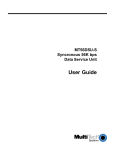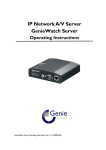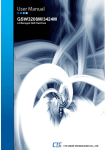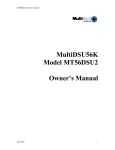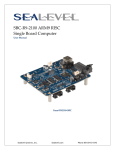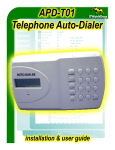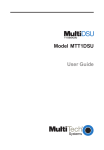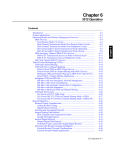Download Multitech MT56DSU-R Owner`s manual
Transcript
MultiDSU56K TM Rack Mount Multi-Rate DSU Model MT56DSU-R Owner's Manual 82023101.p65 1 2/12/01, 2:52 PM Owners Manual P/N 82023101, Rev. B Model No. MT56DSU-R This publication may not be reproduced, in whole or in part, without prior expressed written permission from Multi-Tech Systems, Inc. All rights reserved. Copyright © 1995, by Multi-Tech Systems, Inc. Multi-Tech Systems, Inc. makes no representations or warranties with respect to the contents hereof and specifically disclaims any implied warranties of merchantability or fitness for any particular purpose. Furthermore, Multi-Tech Systems, Inc. reserves the right to revise this publication and to make changes from time to time in the content hereof without obligation of Multi-Tech Systems, Inc. to notify any person or organization of such revisions or changes. Record of Revisions Revision Description A (06/07/93) Manual released. All pages at Revision A. B build (01/09/95) Manual revised to change cable port numbers and instructions Trademarks Multi-Tech and the Multi-Tech logo are trademarks of Multi-Tech Systems, Inc. DATAPHONE® is a registered trademark of AT&T. Multi-Tech Systems, Inc. 2205 Woodale Drive Mounds View, Minnesota 55112 USA (612) 785-3500 or (800) 328-9717 Fax 612-785-9874 Tech Support (800) 972-2439 BBS (612) 785-9875 or (800) 392-2432 82023101.p65 2 2/12/01, 2:52 PM Contents Chapter 1 - Introduction and Description 1.1 1.2 1.3 1.4 Introduction ............................................................................... 6 About This Manual ................................................................... 6 Description ................................................................................ 7 CSU/DSU Basics ..................................................................... 8 1.4.1 DSU Functions .............................................................. 8 1.4.2 CSU Functions .............................................................. 8 1.5 Features .................................................................................... 9 1.6 FCC Regulations for Telephone Line Interconnection ..... 10 1.7 Specifications .......................................................................... 12 Chapter 2 -Hardware Installation 2.1 2.2 Introduction ............................................................................. 16 Default DIP Switch and Jumper Settings ........................... 16 2.2.1 12 -Position DIP Switch (# 1-12) .............................. 17 2.2.2 4-Position DIP Switch (# 13-16) ............................... 17 2.2.3 RS232/V.35 Shunt ....................................................... 17 2.3 Changing the Default DIP Switch Settings ........................ 18 2.4 Installation Procedure ........................................................... 20 Chapter 3 - Operation 3.1 3.2 Introduction ............................................................................. 24 Options .................................................................................... 24 3.2.1 Data Rate ..................................................................... 24 3.2.2 Async/Sync .................................................................. 24 3.2.3 Anti-Streaming ............................................................. 25 3.2.4 Elastic Store ................................................................. 25 3.2.5 System Status .............................................................. 26 3.2.6 Circuit Assurance ........................................................ 26 3.2.7 Clocking ........................................................................ 27 3.2.8 RTS Forced On ........................................................... 27 3.2.9 DSR Forced On ........................................................... 28 3.2.10 Async Word Length .................................................... 28 iii 82023101.p65 3 2/12/01, 2:52 PM 3.3 3.4 3.2.11 Normal/Diagnostics ..................................................... 28 LED Indicators ........................................................................ 29 Functions ................................................................................. 29 3.4.1 Local Area Data Set Applications ............................. 29 3.4.2 Off-Net Extension Applications ................................. 30 Chapter 4 - Troubleshooting 4.1 4.2 Introduction ............................................................................. 32 LED Indicators ........................................................................ 32 4.2.1 RCV Indicator .............................................................. 33 4.2.2 XMT Indicator ............................................................... 33 4.2.3 CD Indicator ................................................................. 33 4.2.4 56K Indicator ................................................................ 33 4.2.5 19.2 Indicator ............................................................... 33 4.2.6 CTS Indicator ............................................................... 33 4.2.7 RTS Indicator ............................................................... 34 4.2.8 NS Indicator ................................................................. 34 4.2.9 TM Indicator ................................................................. 34 4.2.10 OOS Indicator .............................................................. 34 4.3 Diagnostic Tests ..................................................................... 35 4.3.1 Local Loopback Test ................................................... 35 4.3.2 Digital Loopback Test ................................................. 36 4.3.3 Digital Loopback With Test Pattern Test .................. 37 4.3.4 Test Pattern Test .......................................................... 38 4.3.5 DSU Loopback Test .................................................... 39 4.3.6 DSU Back-to-Back Test ............................................. 40 Chapter 5 - Warranty, Service and Tech Support 5.1 5.2 5.3 5.4 Service ..................................................................................... 42 Limited Warranty .................................................................... 42 Tech Support and BBS .......................................................... 43 Recording DSU Information ................................................. 43 Appendixes Appendix A - Application Examples ............................................... 46 Appendix B - Interface Signals and Connector Pinouts ............. 50 Glossary iv 82023101.p65 4 2/12/01, 2:52 PM MultiDSU56K TM Chapter 1 - Introduction and Description 82023101.p65 5 2/12/01, 2:52 PM MT56DSU-R Owner's Manual 1.1 Introduction Congratulations! Your new MT56DSU-R is one of the finest DSU/ CSUs available today. As a combined CSU (Channel Service Unit) and DSU (Data Service Unit), it provides a direct connection to the DATAPHONE® Digital Service (DDS) network. The MT56DSU-R connects a computer or Data Terminal Equipment (DTE) to remote equipment using DDS network lines at 2400, 4800, 9600, 19200 and 56000 bps speeds for point-to-point and multi-point service. 1.2 About This Manual This manual contains five chapters and two appendixes. In addition, there is a Glossary and an Index at the end of this manual. The information in this manual is provided as described below. Chapter 1 - Introduction and Description contains an introduction to the MT56DSU-R product and its features and functions. Chapter 2 - Hardware Installation provides configuration and installation procedures. Chapter 3 - Operation describes the functional features and options of the MT56DSU-R. Chapter 4 - Troubleshooting explains what to do if your MT56DSU-R encounters problems in operation. Chapter 5 - Service, Warranty and Tech Support defines procedures to follow if the troubleshooting steps in Chapter 4 do not fix the problem. Appendix A - Applications Examples illustrates several DSU/CSU uses that may help in understanding your particular installation site. Appendix B - Interface Signals lists the various electronic signals and connector pinouts related to the MT56DSU-R. 6 82023101.p65 6 2/12/01, 2:52 PM Chapter 1 - Introduction and Description 1.3 Description The MT56DSU-R is a rack-mounted DSU/CSU that is easy to operate and has the features to allow flexibility in meeting your transmission requirements. The DDS is a service for transmission of digital signals via digital transmission facilities exclusively. The MT56DSU-R is designed to meet AT&T Technical Publication 62310 requirements. As such, the MT56DSU-R provides all of the functions required on the customer side of the network. The MT56DSU-R provides user selection of synchronous data communications at rates of 2400, 4800, 9600, 19200 and 56000 bps, and asynchronous data communications rates up to 19200 bps. It provides three separate interface connections (RS232C, V.35 and DDS). You will find the MT56DSU-R easy to install, use and maintain. It is recommended that you read the entire manual early in your experience with the MT56DSU-R so you can appreciate all of the MT56DSU-R features and options. 7 82023101.p65 7 2/12/01, 2:52 PM MT56DSU-R Owner's Manual 1.4 CSU/DSU Basics A DSU (Data Service Unit) and a CSU (Channel Service Unit) are typically connected to provide the interface between a DTE (data terminal equipment) and the DDS (Digital Data Service) or other four-wire network. The DSU is used to process serial synchronous or asynchronous digital data over the DDS network or other four-wire unloaded twisted-pair wiring network. The MT56DSU-R can transmit data at 56000, 19200, 9600, 4800 and 2400 bps in multi-point and point-to-point applications. The MT56DSU-R contains the functions of a Data Service Unit (DSU) and a Channel Service Unit (CSU) in a single package. 1.4.1 DSU Functions The DSU encodes data as pulses on the communications line by converting the customer data stream to bipolar format for transmission over the digital network. 1.4.2 CSU Functions The CSU is used to terminate the digital circuit at the customer site. It performs line conditioning functions, ensures network compliance with FCC rules, and responds to test commands (either from the telco central office (CO) or from the CSU). The figure below shows the MT56DSU-R in a basic DDS network installation. Figure 1-1. Basic DSU/CSU Configuration 8 82023101.p65 8 2/12/01, 2:52 PM Chapter 1 - Introduction and Description 1.5 Features The MT56DSU-R provides many useful features. Standard features include V.35 and RS232 connections and either synchronous and asynchronous transmission; synchronous at rates up to 56000 bps and asynchronous up to 19200 bps; selectable digital data rates that match the services offered by the carriers. Other features include user-selectable clocking options, elastic store for analog offnet extensions, anti-streaming, and RTS and DSR signal forced-on selection. Your Multi-Tech DSU/CSU provides the following features: supports direct connection to the DATAPHONE ® Digital Data Service (DDS) or compatible network selectable sync speeds of 2400, 4800, 9600, 19200 and 56000 bps selectable async speeds of 2400, 4800, 9600, and 19200 bps point-to-point and multipoint operation Standard RS232C, V.35 and DDS interfaces provided anti-streaming (for multi-point operations) elastic store (for analog off-net extensions) system status circuit assurance multiple selectable clocking * External clocking * Internal clocking * DDS (slave) clocking RTS signal forced on selection DSR signal forced on selection multiple MT56DSU-R activated diagnostic tests: * Local loopback test * Digital loopback test * Test pattern generator/detector multiple telco-activated diagnostic tests: * DSU loopback test * CSU loopback test 9 82023101.p65 9 2/12/01, 2:52 PM MT56DSU-R Owner's Manual 1.6 FCC Regulations for Telephone Line Interconnection 1. This equipment complies with Part 68 of the FCC rules. On the outside surface of the rack is a label that contains, among other information, the FCC registration number and ringer equivalence number (REN). If requested, this information must be provided to the telephone company. 2. As indicated in Appendix B, the suitable jack (USOC) connection arrangement for this equipment is shown. If applicable, the facility interface codes (FIC) and service order codes (SOC) are shown. 3. The ringer equivalence number (REN) is used to determine the quantity of devices which may be connected to the telephone line. Excessive REN's on the telephone line may result in the devices not ringing in response to an incoming call. In most, but not all areas, the sum of the REN's should not exceed five (5.0). To be certain of the number of devices that may be connected to the line, as determined by the total REN's, contact the telephone company to determine the maximum REN for the calling area. 4. If this equipment causes harm to the telephone network, the telephone company will notify you in advance. But if advance notice isn't practical, the telephone company will notify the customer as soon as possible. Also, you will be advised of your right to file a complaint with the FCC if you believe it is necessary. 5. The telephone company may make changes in its facilities, equipment, operation, or procedures that could affect the operation of the equipment. If this happens, the telephone company will provide advance notice in order for you to make necessary modification in order to maintain uninterrupted service. 6. If trouble is experienced with this equipment (the model of which is indicated below) please contact Multi-Tech Systems, Inc. at the address shown below for details of how to have repairs made. If the trouble is causing harm to the telephone network, the telephone company may request you remove the equipment from the network until the problem is resolved. 10 82023101.p65 10 2/12/01, 2:52 PM Chapter 1 - Introduction and Description 7. No repairs are to be made by you. Repairs are to be made only by Multi-Tech Systems or its licensees. Unauthorized repairs void registration and warranty. 8. This equipment cannot be connected to public coin service provided by the telephone company. (Contact the state public utility commission, public service commission or corporation commission for information.) Manufacture: Multi-Tech Systems, Inc. Model number: MT56DSU-R FCC Registration No.: AU7USA-18883-DE-N Ringer Equivalence: N/A Modular Jack (USOC) RJ48S Service Center in U.S.A.: Multi-Tech Systems, Inc. 2205 Woodale Drive Mounds View, MN 55112 (612) 785-3500 or (800) 328-9717 U.S. Fax (612) 785-9874 11 82023101.p65 11 2/12/01, 2:52 PM MT56DSU-R Owner's Manual 1.7 Specifications Model Number MT56DSU-R Device Operation combined DSU and CSU Data Rates Synchronous Asynchronous 2400, 4800, 9600, 19200, 56000 bps 2400, 4800, 9600, 19200 bps Interfaces RS232C, V.35, DDS Temperature 0 to 50o C Humidity 95% (non-condensing) Dimensions 0.75" H x 5.5" W x 10.4" D 1.8 cm H x 13.5 cm W x 26 cm D Weight 0.6 Lbs. (0.3 Kg.) CertificationFCC Part 15 Class A FCC Part 68 UL Listed Compatibility AT&T Pubs 62310 and 41450 FIC Codes 04DU5-24 04DU5-48 04DU5-96 04DU5-19 04DU5-56 2.4 Kbps digital interface 4.8 Kbps digital interface 9.6 Kbps digital interface 19.2 Kbps digital interface 56 Kbps digital interface USOC Jack R J 4 8 S Transmitter/Receiver Modulation bipolar return to zero Transmit Level 1.4V peak (+6dBm) into 135 Ohm at 2400, 4800,19200, and 56000 bps bps 0.7V peak (0 dBm) into 135 ohm at 9600 Output Impedance 135 ohms Receive Levels +6 to -40 dbm at 2400 bps +6 to -40 dBm at 4800 bps 0 to -40 dBm at 9600 bps +6 to -40 dBm at 19200 bps +6 to -45 dBm at 56000 bps 12 82023101.p65 12 2/12/01, 2:52 PM Chapter 1 - Introduction and Description Input Impedance 135 ohms Delay Times (in msecs.) RTS/CTS DCD on DCD off 2400 4800 9600 19200 56000 8.1 4.3 2.2 1 0.4 7.5 2.6 1.6 0.8 0.3 7.0 3.5 1.5 0.7 0.2 13 82023101.p65 13 2/12/01, 2:52 PM MT56DSU-R Owner's Manual 14 82023101.p65 14 2/12/01, 2:52 PM MultiDSU56K TM Chapter 2 -Hardware Installation 82023101.p65 15 2/12/01, 2:52 PM MT56DSU-R Owner's Manual 2.1 Introduction This chapter provides the information needed to configure and install the MT56DSU-R in a Multi-Tech Systems CC216G modem rack. This manual assumes the reader is familiar with the function and operation of data communications equipment and is technically qualified to provide installation service. 2.2 Default DIP Switch and Jumper Settings The MT56DSU-R printed circuit board contains a 12-position DIP switch block which is labeled 1 through 12 and a 4-position DIP switch block which is labled 13 through 16 as shown in Figure 2-1. They are located behind the LEDs on the front of the board. Each individual switch is numbered and can be in either the up (OPEN) or down (CLOSED) position. The MT56DSU-R is shipped from the factory with the configuration DIP switches set to the most common settings. The factory-set (default) settings are: 56K Data Rate, DDS Clocking, RTS Forced On, DSR Forced On, Sync Mode, Loopback Test Disabled, Test Pattern Disabled, Circuit Assurance Disabled, System Status Disabled, 10-Bit Async Word Length, Elastic Store Disabled, and Anti-Streaming Disabled. If you need to change any of these settings, refer to the Changing Defaults sections below. The MT56DSU-R switches are shown below. Figure 2-1. MT56DSU-R Board Layout 16 82023101.p65 16 2/12/01, 2:52 PM Chapter 2 - Hardware Installation 2.2.1 12 -Position DIP Switch (# 1-12) The 12-position DIP switch is used to set data rate, clocking, RTS control, DSR control, and Async/Sync operation, diagnostic modes (Loopback Test, Test Pattern ), Circuit Assurance, and System Status. The default settings are shown in Table 2-1. If you want to make changes to one of these settings, refer to section 2.3. 2.2.2 4-Position DIP Switch (# 13-16) The 4-position DIP switch is used to select Async Word Length, Elastic Store, and Anti-Streaming options. The defaults are 10-Bit Async Word Length, Elastic Store disabled, and Anti-Streaming disabled. If changes to these settings are required, refer to section 2.3. 2.2.3 RS232/V.35 Shunt Data terminal equipment with either a RS232 or V.35 interface can be connected to the DB25 connector on the backplane of the rack. The 16-pin shunt on the back of the MT56DSU-R board must be placed in either the "V.35 position or the "RS232" position. The interface is determined by the position of this 16-pin shunt. The MT56DSU-R is shipped from the factory with the 16-pin shunt in the RS232 position. 17 82023101.p65 17 2/12/01, 2:52 PM MT56DSU-R Owner's Manual 2.3 Changing the Default DIP Switch Settings Use Table 2-1 to determine the DIP switch setting changes required for your MT56DSU-R to operate in your particular environment. You may want to record your switch setting changes for future reference (e.g., troubleshooting, equipment moves/changes, calling Tech Support). The DIP switches are illustrated in Figure 2-1. The factory default settings are indicated by an * in the Table 2-1. Table 2-1. MT56DSU-R Switch Settings Switch Description Data Rate (in bps) -1 -2 -3 2400 4800 9600 19.2K 56K (*) Down Down Down Down Up Down Down Down Up Down Up Up Up * Up * Up * Clocking -4 -5 Internal External DDS (*) Up Up Down Down Down * Up * RTS Control -6 Up - RTS controlled by DTE Down - RTS forced On * DSR Control -7 Up - DSR depends on the status of the link Down - DSR forced on * Async/Sync Operation -8 Up - Synchronous operation * Down - Asynchronous operation 18 82023101.p65 18 2/12/01, 2:52 PM Chapter 2 - Hardware Installation Table 2-1. MT56DSU-R Switch Settings (Cont'd) Switch Description Normal/Diagnostics Mode -9 Up - normal operating mode * Down - Loopback Test enabled -10 Up - normal operating mode * Down - Test Pattern enabled Link Status Options -11 Up - Circuit Assurance disabled * Down - Circuit Assurance enabled -12 Up - System Status disabled * Down - System Status enabled Async Word Length -13 -14 9-Bit 10-Bit* 11-Bit Up Down Down * Up * Up Up Elastic Store -15 Up - Elastic Store disabled * Down - Elastic Store enabled Anti-Streaming -16 Up - Anti-Streaming enabled Down - Anti-Streaming disabled * * Factory default selection 19 82023101.p65 19 2/12/01, 2:52 PM MT56DSU-R Owner's Manual 2.4 Installation Procedure After your CC216G modem rack has been installed in your computer cabinet or in a stand-alone cabinet of your choosing, the MT56DSUR can be inserted into the rack. Refer to the Rack Mounted Modems Owner's Manual for rack installation procedures. Then, perform the following procedure in Table 2-2 to install the MT56DSU-R. Table 2-2. Installation 1. Verify that the DIP switches on the MT56DSU-R are set for your particular configuration; refer to Table 2-1. 2. Before the MT56DSU-R is inserted into the modem rack, the 16-pin shunt on the back of the board needs to be in correct position. If the MT56DSU-R is being connected to a RS232 interface, the 16-pin shunt needs to be placed in the "RS-232" position. If the MT56DSU-R is being connected to a V.35 interface, place the 16-pin shunt in the "V.35" position. 3. Determine which slot the MT56DSU-R board is going to be placed in the rack. Apply the DSU LED sticker to the door, refer to the Rack Mounted Modems Owner's Manual for the notes about the CC216G. 4. Open the door of the modem rack. 5. Ensure that the MT56DSU-R board is positioned so that the LEDs are toward the top of the board, insert the board in the slot you have choosen to add the DSU LED sticker. The board's gold edge connector will mate with the rack's backplane. The edge connector is offset so that the board cannot be inserted incorrectly. 6. To connect the DTE to the MT56DSU-R using an RS232 cable, connect the cable to the RS232 port on the DTE and the other end to the DB25 connector on the back of the rack. Refer to the Rack Mounted Modems Owner's manual for cable connections. 20 82023101.p65 20 2/12/01, 2:52 PM Chapter 2 - Hardware Installation Table 2-2. Installation (cont'd) 7. To connect the DTE to the MT56DSU-R using a V.35 interface, connect the V.35 Interface Adapter cable (CADSUR35) supplied by Multi-Tech to the V.35 interface on the DTE and the other end to the DB25 connector on the back of the rack. Refer to Appendix A in this manual for V.35 Interface Adapter cable information. Refer to the Rack Mounted Modems Owner's manual for cable connections on the rack. 8. To connect the phone line to the MT56DSU-R using the phone cable supplied by Multi-Tech, connect the DB9 connector of the cable to the DB9 connector on the rack and the RJ-48 connector to the wall jack. Refer to Appendix A in this manual for the phone cable information. Refer to the Rack Mounted Modems Owner's manual for the DB9 connection on the rack. 21 82023101.p65 21 2/12/01, 2:52 PM MT56DSU-R Owner's Manual 22 82023101.p65 22 2/12/01, 2:52 PM MultiDSU56K TM Chapter 3 - Operation 82023101.p65 23 2/12/01, 2:52 PM MT56DSU-R Owner's Manual 3.1 Introduction This chapter provides information on the operating functions of the MT56DSU-R. During normal operation the MT56DSU-R requires no operator intervention. Many of the optional features of the MT56DSU-R are selected by setting a switch. Please refer to changing the default DIP switch settings in Installation (Chapter 2) to change your particular environment. 3.2 Options The switchable features of the MT56DSU-R are: Data Rate Async/Sync Anti-Streaming Elastic Store System Status Circuit Assurance Clocking RTS Forced On DSR Forced On Async Word Length Normal/Diagnostics The MT56DSU-R has a pre-configured (default) setting for each of these options when shipped from the factory. Chapter 2 of this manual covers the changing of these option DIP switches. Chapter 4 covers the Normal/Diagnostic switch function. The following sections describe the option in terms of the operation of the MT56DSU-R in a DDS or other 4-wire network. 3.2.1 Data Rate This option allows selection of the MT56DSU-Rs data transmission rate. The data rate selected here must match the DDS or other 4wire network line rate that you subscribed for with your telco. The default for this function is a data rate of 56K bps. (Refer to Chapter 2 for option switch selection.) 3.2.2 Async/Sync This option allows selection of the MT56DSU-Rs type of data transmission used. The transmission type selected here must match the DTE. The default is sync (synchronous data transmission). 24 82023101.p65 24 2/12/01, 2:52 PM Chapter 3 - Operation 3.2.3 Anti-Streaming This option is typically enabled on remote DSUs using multi-point lines. When enabled, the anti-streaming feature prevents a streaming (jammed) DTE from affecting the communications from remote sites(in a multi-point circuit) that are operating properly. When Anti-Streaming is enabled, the MT56DSU-R will detect when the DTE device holds RTS (Request To Send) on for longer than 20 seconds. The MT56DSU-R then forces RTS and CTS off internally and sends the DDS Idle Channel signal to the network. The DTEs interface is ignored until the streaming DTE is repaired. The RTS LED is continuously lit and the CTS LED is off when a streaming DTE has been detected. The default for this function is Anti-Streaming disabled. (Refer to Chapter 2 for changing the default DIP switch settings.) 3.2.4 Elastic Store This function allows the MT56DSU-R to compensate for small timing phase drifts that occur in applications using analog modems for off-net (non-DDS) extensions. An analog off-net extension application is described in Appendix A. This option should be enabled on all MT56DSU-Rs that are connected to analog modems. Notes for off-net (elastic store enabled) sites: a special DCE-DCE cross-over cable is required (not supplied by Multi-Tech). the modem located with the MT56DSU-R must be set for external timing. The modem located at the far end of the off-net extension must be set for slave timing. with applications using controlled carrier, the CTS delay of the far-end modem of the off-net extension must be set for a longer period than the MT56DSU-Rs CTS delay time. The default for this function is Elastic Store disabled. (Refer to Chapter 2 for changing the default DIP switch settings.) 25 82023101.p65 25 2/12/01, 2:52 PM MT56DSU-R Owner's Manual 3.2.5 System Status With this option enabled, the MT56DSU-R conditions the DSR signal with additional parameters to provide added information to the connected DTE concerning the Ready status of the communications channel. Normally when this option is enabled, this signal is on when the MT56DSU-R is powered on and not in test mode. On most modems, the Data Set Ready (DSR) signal at the DTE interface is used to provide a basic indication of the modem actually being ready to transfer data. The System Status option simply provides a better means of informing the DTE of a ready condition. The default for this function is System Status disabled, preventing the DTE from interpreting momentary line interruptions as a communications channel failure. (Refer to Chapter 2 for changing the default DIP switch settings.) 3.2.6 Circuit Assurance This option, when enabled, causes the MT56DSU-R to condition the CTS signal to inform the DTE of the transmit ready status of the entire communications channel. In most installations, the CTS signal at the DTE interface is the basic RTS signal delayed in time. Even though this could imply that the communications channel is ready for data to be sent, it is not typically conditioned by channel status to indicate an actual ready status. With the Circuit Assurance function enabled, the MT56DSU-R does not turn the CTS signal on unless both the CD is on and the RTS/ CTS delay has timed out. The default for this function is Circuit Assurance disabled. (Refer to Chapter 2 forchanging the default DIP switch settings.) 26 82023101.p65 26 2/12/01, 2:52 PM Chapter 3 - Operation 3.2.7 Clocking This option allows selection of the MT56DSU-Rs clocking (timing for synchronization) from one of three sources. These clocking sources are discussed below. Internal clocking enables the MT56DSU-R to accept timing from its internal timing oscillator. External clocking allows the MT56DSU-R to derive timing from any external device that can supply timing to the External Transmit Clock line on the MT56DSU-Rs DTE interface connector. This external clock must be within 0.008% of the nominal data rate. DDS timing allows the MT56DSU-R to accept timing signals from the DDS networks receive bipolar signal. Use this selection whenever the MT56DSU-R is connected to the DDS network lines. The default for this function is DDS Clocking enabled. (Refer to Chapter 2 for changing the default DIP switch settings.) 3.2.8 RTS Forced On With this option enabled, the MT56DSU-R provides a continuous CTS signal, disregarding the state of the RTS signal at the DTE interface connector. This will provide a continuous outbound indication to the network and remote (far-end) device that there is a Carrier on condition. For many (e.g., point-to-point) networks, it is best to maintain a carrier on status on the communications channel to help minimize line turnaround delays. This option is usually enabled for central site DSU installations with multi-point lines (i.e., when continuous outbound carrier on is desired). This option must be disabled on the remote station of a multi-point installation. When this option is disabled, the MT56DSU-R receives and uses the RTS signal from the DTE. The default for this function is RTS Forced On. (Refer to Chapter 2 for changing the default DIP switch settings.) 27 82023101.p65 27 2/12/01, 2:52 PM MT56DSU-R Owner's Manual 3.2.9 DSR Forced On When this option is enabled, the MT56DSU-R forces the DSR signal on continuously regardless of the condition of the received DDS signal (OOS or Test). The permanent DSR signal is used to eliminate momentary link interruptions that may be interpreted by the DTE as a communications channel failure. With this option disabled, the DSR is handled as described in the System Status section earlier in this chapter. The default for this function is DSR Forced On. (Refer to Chapter 2 for changing the default DIP switch settings.) 3.2.10 Async Word Length This option allows you to select the word length to be used by the MT56DSU-R for asynchronous data transmissions. The Async Word Length selections are 9-, 10- and 11-bits. The async word length selected here must match the async word length set at the DTE. The default for this function is a 10-bit async word(1 start, 8 data, no parity, 1 stop bit) length. (Refer to Chapter 2 for changing the default DIP switch settings.) 3.2.11 Normal/Diagnostics The default for this option is Normal (standard CSU/DSU operation). For information on the Diagnostics selection, refer to Chapter 4. 28 82023101.p65 28 2/12/01, 2:52 PM Chapter 3 - Operation 3.3 LED Indicators The front panel of the MT56DSU-R contains ten LED indicators that can help in troubleshooting network or device problems. Chapter 4 of this manual contains detailed information on the LED indicators. 3.4 Functions This section describes the two optional MT56DSU-R modes of operation. The MT56DSU-R can be used as either a point-to-point Local Area Data Set (at speeds up to 56K bps), or in an off-net extension application using conventional analog lines and modems (to complete DDS communications in areas without DDS availability). 3.4.1 Local Area Data Set Applications Your MT56DSU-R can be used as a point-to-point LADS (Local Area Data Set) at transmission speeds of 2400, 4800, 9600, 19200 or 56000 bps over 4-wire, non-loaded metallic wire pairs. The MT56DSU-R conforms to the signal power requirements of Bellcore Pub. 41028 (data sets used on LADC), when used at subrate speeds (less than or equal to 19200 bps). The MT56DSU-R does not meet this requirement at the 56K bps rate. The 56K bps rate may be used in applications with customer-supplied lines, or lines not covered by Pub 41028, or other tariff requirements. The installation of the MT56DSU-R in a LADS application is the same as for DDS applications, except for the timing (Clocking) setting. LADS applications require one MT56DSU-R to be set for Internal timing and the other MT56DSU-R to be set for DDS timing (refer to Chapter 2 of this manual). The network cable connection requires cross-over wiring; the transmit pair of each MT56DSUR must be connected to the receive pair of the far-end MT56DSU-R. The MT56DSU-R uses 4-wire non-loaded metallic circuits for LADS applications. The table below outlines approximations for the maximum cable length for limited distance applications. 29 82023101.p65 29 2/12/01, 2:52 PM MT56DSU-R Owner's Manual Data Rate 2400 bps 4800 bps 9600 bps 19200 bps 56000 bps 19 AWG 22.0 19.0 15.0 11.9 10.0 Wire Gage 22 AWG 15.0 13.0 10.0 7.0 6.0 24 AWG 12.0 10.0 7.0 5.0 4.2 26 AWG 9.5 miles 8.0 miles 5.5 miles 4.0 miles 3.0 miles Note that line characteristics will vary depending on cable type/ manufacturer, splices, bridge taps, etc. An example of a typical LADS application is shown in Appendix A of this manual. 3.4.2 Off-Net Extension Applications The MT56DSU-R can be used as an off-net extension with standard analog modems and lines to complete DDS circuits in areas where the DDS is not available or where a customer requirement is for an extension of the circuit for a special application. In applications using the MT56DSU-R for an off-net extension, one MT56DSU-R may be set for External Timing and the other set for DDS Timing; however, in this application, the clock (timing) being supplied must be accurate to +/-0.008% of the enabled data transmission rate. The Elastic Store option is used in off-net extension applications with analog modems to compensate for small timing phase drifts that typically occur in such applications. A cross-over cable is required to connect the MT56DSU-R DTE connector to the analog modem in this application. The analog modem at the same end as the MT56DSU-R must have External Timing enabled; the modem at the end of the off-net extension must have Slave Timing enabled. In MT56DSU-R applications that use controlled carrier, the CTS delay for the analog modem at the end of the off-net extension must be longer than the CTS delay of the MT56DSU-R. An example of a typical off-net extension application is shown in Appendix A of this manual. 30 82023101.p65 30 2/12/01, 2:52 PM MultiDSU56K TM Chapter 4 - Troubleshooting 82023101.p65 31 2/12/01, 2:52 PM MT56DSU-R Owner's Manual 4.1 Introduction All of the indicators used in normal operation of the MT56DSU-R are labeled on the LED overlay on the rack door. Each LED is labeled, as explained below. The LEDs provide status and maintenance information on the MT56DSU-R, as well as the attached network and line. There are no door switches on the MT56DSU-R. 4.2 LED Indicators The door contains ten LEDs each with a two- or three-letter overlay describing its meaning. During normal operation, the LEDs light (flash or continuously lit) to indicate the operating status. During test mode, the LEDs light during Test Pattern test execution (refer to the Test Pattern section later in this chapter). The LED overlay is shown in Figure 4-1. The top three letters (DSU) on the overlay describe the type of board in the slot behind the overlay. There is no LED behind the top three letters. The LEDs are described in the following paragraphs. Figure 4-1. LED Overlay 32 82023101.p65 32 2/12/01, 2:52 PM Chapter 4 - Troubleshooting 4.2.1 RCV Indicator The RCV (Receive) LED lights when the MT56DSU-R receives data ( 0 or a space) from the network. This LED should appear to flash during normal data reception. 4.2.2 XMT Indicator The XMT (Transmit) LED lights to indicate the DTE is sending data (0 or a space) across the DTE connector. This LED should appear to flash during normal data transmission. 4.2.3 CD Indicator The CD (Carrier Detect) LED lights when the MT56DSU-R has received the data carrier from the network. This indicator will go off when the MT56DSU-R is receiving the idle code or no signal at all. If RTS is off on the remote DSU, the remote sends an idle code to the local DSU. 4.2.4 56K Indicator The 56K LED lights when the Data Rate selection is set at 56000 bps. This indicator will be off for all other data rates. Refer to Chapter 2 for switch settings. 4.2.5 19.2 Indicator The 19.2 LED lights when the Data Rate selection is set at 19200 bps. This indicator will be off for all other data rates. Refer to Chapter 2 for switch settings. 4.2.6 CTS Indicator The CTS (Clear to Send) LED lights when the MT56DSU-R generates a CTS in response to either an RTS signal received at the DTE connector, or RTS forced on by the corresponding DIP switch. CTS is always off during a No Signal condition. If the Circuit Assurance option is enabled, the CTS will be off whenever Carrier Detect is off. 33 82023101.p65 33 2/12/01, 2:52 PM MT56DSU-R Owner's Manual 4.2.7 RTS Indicator The RTS LED lights when the RTS signal is received from the DTE. The DIP switch for RTS Forced On does not affect this indicator. Refer to Chapter 2 for switch settings. 4.2.8 NS Indicator The NS (No Signal) LED lights when no signal at all is received from the network, or when the signal is too weak for normal MT56DSU-R operation. This indicator will also flash to indicate that errors have been detected when using the Test Pattern diagnostic feature. 4.2.9 TM Indicator The TM (Test Mode) LED lights when one of the Test switches is set to the down (Test enabled) position. When the TM LED is lit, normal operation (network transmit/receive) cannot occur. Refer to the Diagnostic Tests section for more information. 4.2.10 OOS Indicator The OOS (Out of Service) LED lights when an outage condition exists. This occurs when there is a failure in the digital service detected by the network, and the telco sends a repetitive OOS sequence. If this indicator is on , check the remote DSU for proper installation and operation. If the remote DSU is installed and operating correctly, then report the Out-Of-Service condition to the telephone company. 34 82023101.p65 34 2/12/01, 2:52 PM Chapter 4 - Troubleshooting 4.3 Diagnostic Tests The MT565SU-R is set to a default of Normal (non-diagnostic) mode at the factory. When diagnostics are to be run, change the DIP switches as described in Chapter 2 of this manual. When a failure occurs in the digital facility (telco equipment), the network will detect the failure and send a repetitive OOS signal sequence to your equipment. Your equipment can detect local loop failure by the absence or distortion of the digital signal. If an OOS is received when data is expected, check the remote (far-end) transmitting equipment. If the remote equipment is transmitting properly, contact your telephone company. If the telco is required to perform remote tests, the channel will be temporarily interrupted and loss of data may occur. The following sections describe the tests that are available for the MT56DSU-R. 4.3.1 Local Loopback Test This test allows you to test the local DTE and local MT56DSU-R. Use the following steps to perform the Local Loopback Test. 1. Set DIP switch #9 to the down position. 2. The Test (TM) LED lights, and if you send data from your DTE, it should be looped back to your DTE. If you have access to a Bit Error Rate Tester, this can be used in place of the DTE. 35 82023101.p65 35 2/12/01, 2:52 PM MT56DSU-R Owner's Manual 4.3.2 Digital Loopback Test This test allows you to test the local DTE, the local MT56DSU-R, the communications link, and the remote MT56DSU-R. Use the following steps to perform the Digital Loopback Test. 1. Set DIP switch #9 on the remote MT56DSU-R to the down position. 2.The Test (TM) LED lights, and if you send data from the local DTE, it should be looped back to the local DTE. If you have access to a Bit Error Rate Tester, this can be used in place of the local DTE. 36 82023101.p65 36 2/12/01, 2:52 PM Chapter 4 - Troubleshooting 4.3.3 Digital Loopback With Test Pattern Test This test allows you to test the local MT56DSU-R, the communications link, and the remote MT56DSU-R. Use the following steps to perform the Digital Loopback Test with the Pattern Test. With this test enabled, the MT56DSU-R sends and detects a predefined 15-bit pseudo-random test pattern. When an error is detected by the MT56DSU-R, the NS (No Signal) LED flashs. 1. Set DIP switch #9 on the remote MT56DSU-R to the down position 2. Set DIP switch #10 on the local MT56DSU-R to the down position. 3. The test pattern is generated and either detected as a good test pattern (test patterns match) or as a failed test (test pattern received does not match the pattern sent). 37 82023101.p65 37 2/12/01, 2:52 PM MT56DSU-R Owner's Manual 4.3.4 Test Pattern Test This test allows you to test the local MT56DSU-R, the communications link, and the remote MT56DSU-R. With this test enabled, the MT56DSU-R sends and detects a predefined 15-bit pseudo-random test pattern. When an error is detected by the MT56DSU-R, the NS (No Signal) LED flashs. To enable the Test Pattern Test, perform the following. 1. Set the DIP switch # 10 on both the local and remote MT56DSU-R boards to the down position. 2. The test pattern is generated and either detected as a good test pattern (test patterns match) or as a failed test (test pattern received does not match the pattern sent). 38 82023101.p65 38 2/12/01, 2:52 PM Chapter 4 - Troubleshooting 4.3.5 DSU Loopback Test This test lets you verify proper MT56DSU-R operation by matching a transmitted signal to the "looped-back" receive signal. Refer to Appendix B for cable description. 1. Obtain a DSU Loopback cable (CADSURLB) from Multi-Tech, or assemble one. Refer to Appendix B for instructions on building the Loopback cable . 2. Plug the Loopback cable into the DB9 connector on the DSU being tested. 3. If you send data from your DTE, it should be "looped back" to your DTE. If you have access to a Bit Error Rate Tester, this can be used in place of the DTE. 39 82023101.p65 39 2/12/01, 2:52 PM MT56DSU-R Owner's Manual 4.3.6 DSU Back-to-Back Test This test lets you connect two MT56DSU-Rs with a back-to-back cable to verify proper DSU operation. Using a DSU that is known to be operational, you can test a second DSU that is suspect. 1. Obtain a DSU Back-to-Back cable (CADSURBB) from MultiTech, or assemble one. Refer to Appendix B for instructions on building the Back-to-Back cable . 2. On the good DSU board, set DIP switch #9 to the down position. 3. Set one DSU to internal clocking and the other DSU to DDS clocking. 4. Plug the Back-to-Back Cable into the line backplane connector on each DSU. 5. If you send data from your DTE, it should be "looped back" to your DTE. If you have access to a Bit Error Rate Tester, this can be used in place of the DTE. 40 82023101.p65 40 2/12/01, 2:52 PM MultiDSU56K TM Chapter 5 - Warranty, Service and Tech Support 82023101.p65 41 2/12/01, 2:52 PM MT56DSU-R Owner's Manual 5.1 Service In the event service is required, equipment may be sent, freight prepaid, to our factory. Return shipping charges will be paid by Multi-Tech Systems. Include a description of the problem, a return shipping address, and a check or purchase order for out-of-warranty repairs. The standard repair charge for an MT56DSU-R is $125. Multi-Tech pays the return freight. Send equipment to this address: MULTI-TECH SYSTEMS, INC. 2205 Woodale Drive Mounds View, Minnesota 55112 Attn: Service You should also check with the people that supplied you with your equipment on the availability of local service and/or loaner units, in your part of the country. You may call us at 1-800-972-2439, or if in Minnesota, at 612-785-3500. 5.2 Limited Warranty Multi-Tech Systems, Inc. (MTS) warrants that its products will be free from defects in material or workmanship for a period of two years from the date of purchase, or if proof of purchase is not provided, two years from date of shipment. MTS MAKES NO OTHER WARRANTY, EXPRESSED OR IMPLIED, AND ALL IMPLIED WARRANTIES OF MERCHANTABILITY AND FITNESS FOR A PARTICULAR PURPOSE ARE HEREBY DISCLAIMED. This warranty does not apply to any products which have been damaged by lightning storms, water, or power surges or which have been neglected, altered, abused, used for a purpose other than the one for which they were manufactured, repaired by the customer or any party without MTSs written authorization, or used in any manner inconsistent with MTSs instructions. MTSs entire obligation under this warranty shall be limited (at MTSs option) to repair or replacement of any products which prove to be defective within the warranty period, or, at MTSs option, issuance of a refund of the purchase price. Defective products must be returned by Customer to MTSs factory transportation prepaid. MTS WILL NOT BE LIABLE FOR CONSEQUENTIAL DAMAGES AND UNDER NO CIRCUMSTANCES WILL ITS LIABILITY EXCEED THE PURCHASE PRICE FOR DEFECTIVE PRODUCTS. 42 82023101.p65 42 2/12/01, 2:52 PM Chapter 5 - Warranty, Service and Tech Support 5.3 Tech Support and BBS Multi-Tech has an excellent staff of tech-support personnel available to help you get the most out of your Multi-Tech product. If you have any questions about the operation of this unit, please call TechSupport at 1-800-972-2439 in the U.S. and Canada. Multi-Tech Systems also maintains a Bulletin Board Service (BBS) for its customers. The information available via the BBS includes: new product information, product upgrade data, problem solving tips and a message service for you to leave questions for which you would like additional information. The phone number for the MultiTech BBS is 1-800-392-2432 in the U.S. and Canada and for Worldwide calls (612) 785-9875. The BBS can be accessed by any asynchronous modem operating at transmission speeds of 14.4K, 9600, 4800, 2400 or 1200 bps. Configurer your modem for no parity, one stop bit and a word length of 8 data bits. 5.4 Recording DSU Information Please fill in the following information on your MT56DSU-R. This will help Tech-Support in answering your question. The same information is requested on the Warranty Registration Card. DSU Model No: _________________ DSU Serial No: _________________ The model number and revision level are on the board. Please note any LED indicator conditions or test results. Use the space below to note the status: 43 82023101.p65 43 2/12/01, 2:52 PM MT56DSU-R Owner's Manual 44 82023101.p65 44 2/12/01, 2:52 PM MultiDSU56K TM Appendixes 82023101.p65 45 2/12/01, 2:52 PM MT56DSU-R Owner's Manual Appendix A - Application Examples Introduction This section illustrates several types of applications in which the MT56DSU-R is typically used. These types include: DDS point-to-point application, DDS multi-point (polled) application, Local Area Data Set, External Clocking application, and Analog Off-Net Extension application DDS Point-To-Point Application In this application, the MT56DSU-R provides the interface between the DDS line and the DTE at your site. Your network provider will provide (at your request) a DDS line connecting the desired locations. The figure below depicts a sample DDS Point-to-point application. Figure A-1. DDS Point-To-Point Application 46 82023101.p65 46 2/12/01, 2:52 PM Appendix A - Application Examples DDS Multi-Point (Polled) Application Since your Central Office (CO) equipment must include Multi-point Junction Units (MJUs) and other special arrangements for this type of service, you may need to coordinate efforts with your network service provider. The MT56DSU-R at the host end is the Master Station (also called the Control Station), which typically has RTS forced on. The attached MT56DSU-Rs are called "Remote stations and have RTS controlled by the DTE. Multi-point DDS provides communication between a control station and two or more remote stations. All data transmitted by the control station is sent to each remote station. For data transmitted from the remote stations, the MJUs combine bit streams from the remote stations into a single, serial bit stream sent to the control station. All stations on the same multi-point circuit must run at the same bit rate (any of the DDS customer service rates). The figure below shows a typical Multi-point (Polled) application. Figure A-2. DDS Multi-Point Polled Application 47 82023101.p65 47 2/12/01, 2:52 PM MT56DSU-R Owner's Manual Local Area Data Set Application In this application, two pairs of wires provide the connection between two MT56DSU-R devices. The two pairs can be up to the equivalent of 3 miles of 26 AWG wire at 56000 bps, or longer for subrate applications (see distances chart in section 3.4.1 of this manual). The figure below depicts a typical Local Area Data Set application. Figure A-3. Local Area Data Set Application External Clocking Application This application is similar to theLocal Area Data Set application except for the timing option setting. In the example below, the DTE connector of the T1 mux is connected to the DTE connector of the MT56DSU-R. Here, the MT56DSU-R must receive timing information from the T1 mux. The MT56DSU-R is set for external timing in this type of application. At the DTE end, DDS timing is selected, providing normal clocking to the DTE. The figure below shows a typical External Clocking application. Figure A-4. External Clocking Application 48 82023101.p65 48 2/12/01, 2:52 PM Appendix A - Application Examples Analog Off-Net Extension Application In this application, the MT56DSU-R is used with conventional analog modems and lines to complete DDS circuits in an area where DDS is not available (Site #3 in the example below) , or where the customer requires an extension of the DDS circuit for a special application. Figure A-5. Analog Off-Net Extension Application 49 82023101.p65 49 2/12/01, 2:52 PM MT56DSU-R Owner's Manual Appendix B - Interface Signals and Connector Pinouts RS232C DB9 CONNECTOR DESCRIPTION This connector ties the MT56DSU-R to the DDS Network. The DB9S connector has the following pinout configuration PIN IDENTIFICATION Pin Description Destination 1 2 3 4 5 6 7 8 9 Transmit Pair N/C Transmit Pair Receive Pair N/C N/C N/C Receive Pair N/C To Line To Line From Line From Line 50 82023101.p65 50 2/12/01, 2:52 PM Appendix B - Interface Signals and Connector Pinouts RS232C DB25S CONNECTOR 13 25 12 Transmitter Signal — 24 Element Timing 23 11 10 22 9 — Test Voltage (+V) 21 8 — Carrier Detect (CD) 20 7 — Signal Ground (SG) 19 6 — Data Set Ready (DSR) 18 5 — Clear To Send (CTS) Receive Clock (RC) — 17 4 — Request To Send (RTS) 16 3 — Received Data (RD) Transmit Clock (TC) — 15 2 — Transmit Data (SD) 14 1 As viewed from the rear DESCRIPTION This connector ties the MT56DSU-R to the DTE. The DB25S connector has the following pinout configuration. PIN IDENTIFICATION Pin 2 3 4 5 6 7 8 9 15 17 24 Description Signal Transmit Data SD Received Data RD Request To Send RT S Clear To Send CTS Data Set Ready DSR Signal Ground S G Carrier Detect CD Test Voltage +V Transmit Clock TC Receive Clock RC DTE Transmitter Signal Element Timing 51 82023101.p65 51 2/12/01, 2:52 PM MT56DSU-R Owner's Manual V.35 INTERFACE ADAPTER CABLE DESCRIPTION This adapter cable should be used when the MTDSU56-R is configured for V.35 DTE interface. You can order the V.35 Interface Adapter cable (CADSUR35) from Multi-Tech. This cable uses a 25pin male connector at one end and a 34-pin Winchester female connector at the other end. SCHEMATIC 52 82023101.p65 52 2/12/01, 2:52 PM Appendix B - Interface Signals and Connector Pinouts LINE CABLE DESCRIPTION This cable lets you connect the MT56DSU-R to your DDS Network. You can order the Line cable (CA248) from Multi-Tech, or build one using the instructions below. SCHEMATIC BUILD INSTRUCTIONS 1. Strip cable insulation 3/4" . 2. Strip wires 1,3,4 and 8 on one end of cable and 1,2,7 and 8 on other end a 1/4" 3. Cut unstriped wires off. 4. Solder wire 1 on one connector to 1 on the other. 5. Solder wire 3 on one connector to 2 on he other.. 6. Solder wire 4 on one connector to 7 on the other.. 7. Solder wire 8 on one connector to 8 on the other.. 8. Cover solder connections with 1"of shrink tube. 53 82023101.p65 53 2/12/01, 2:52 PM MT56DSU-R Owner's Manual LOOPBACK CABLE DESCRIPTION This cable lets you test the MT56DSU-R when a second DSU is not available. It tests the DSU by having the DSU generate a signal, then the cable loops the signal back to the DSU for comparison to the original signal sent. You can order this cable (CADSURLB) from Multi-Tech, or build one using the instructions below. Refer to Chapter 4 for test procedures. SCHEMATIC BUILD INSTRUCTIONS 1. Strip cable insulation 3/4" . 2. Cut wires 2, 5, 6, 7,9 off. 3. Strip wires 1, 3, 4 and 8 a 1/4" 4. Solder wires 1 and 8 together. 5. Solder wires 3 and 4 together. 6. Cover solder connections with 1"of shrink tube. 54 82023101.p65 54 2/12/01, 2:52 PM Appendix B - Interface Signals and Connector Pinouts BACK-TO-BACK CABLE DESCRIPTION This cable lets you test a suspect DSU by connecting it to a known good DSU. It tests the suspect DSU by connecting its Transmit signal to the good DSUs Receive circuits. You can order it from Multi-Tech (CADSURBB), or build one using the instructions below. Refer to Chapter 4 for test procedures. SCHEMATIC BUILD INSTRUCTIONS 1. Strip cable insulation 3/4" . 3. Strip wires 1and 3 on one end of cable and 4 and 8 on other end a 1/4" 2. Cut unstriped wires off. 4. Solder wire 1on one connector to 8 on the other. 5. Solder wire 3 on one connector to 4 on the other.. 6. Cover solder connections with 1"of shrink tube. 55 82023101.p65 55 2/12/01, 2:52 PM MT56DSU-R Owner's Manual 56 82023101.p65 56 2/12/01, 2:52 PM MultiDSU56K TM Glossary 82023101.p65 57 2/12/01, 2:52 PM MT56DSU-R Owner's Manual This section defines several of the terms used in this manual. For an overview of DSU basics, refer to section 1.8 of this manual. A ALBO (Automatic Line Build Out) - part of equalizer circuitry used to compensate for various gauges and alterations of local loops. Anti-Streaming - an option that prevents a streaming (jammed) DTE from affecting other devices on a multi-point network. Asynchronous communications - communications between computer devices at irregular intervals. To do so, the device adds start and stop bits to each character it sends. B BERT (bit error rate tester) - the type of testing used to verify the operating parameters of a data communications line. bps (bits per second) - unit of measure for data transmission. C Central Office (CO) - the telephone company site where switching equipment is located (as opposed to customer premises). Channel - the digital path on a cable on which data is transmitted. A logical way to look at the path data travels when sent between locations. Circuit assurance - an optional conditioning of the CTS signal. Clear To Send (CTS) - an interface signal that indicates whether the modem or DSU is ready to accept a data transmission from the DTE. CO (Central Office) - facility where communications common carriers terminate customer lines and locate line interconnection equipment. Clocking - a synchronous device circuit that sends signals at a precise frequency corresponding to the bit rate of that device. 58 82023101.p65 58 2/12/01, 2:52 PM Glossary Control station - the station on a DDS multipoint circuit that is nearest the host system and transmits data to each remote station and receives a single serial bit stream from the remote stations via the MJU. Crossover cable - a cable with a conductor that runs the length of the cable, but connects to a different pin number at each end (connects pins 2 to 3 and 3 to 2 from DTE to DSU/CSU). CSU (Channel Service Unit) - a device used to terminate a digital circuit (such as DDS or T1) at the customer site. Used in combination with a DSU. D Data Communications Equipment (DCE) - equipment that provides the function to establish, maintain and terminate a connection. Additionally, provides the signal conversion required for communications between DTE and data circuit or telephone line. See also DTE. DDS (Dataphone Digital Service) - AT&Ts private-line end-to-end digital service, with data rates (typically) at 2400, 4800, 9600, 19200, and 56000 bps. Now an AT&T Accunet family offering. The DDS is a synchronous network that uses the ABATS test system, which requires little manual intervention. Default - the factory set position or value that a device assumes at startup. An alterable parameter. Digital loopback - a type of diagnostic test where the transmitted signal is returned to the sending device after passing through a data communications link; the returned signal is then compared to the transmitted signal. DSR (data set ready) - an RS232 signal that indicates the DCE and line are ready to receive data. DSU (Data Service Unit) - a device used to interface a users DSU to a digital circuit (such as DDS or T1). Used in combination with a CSU. Data Terminal Equipment (DTE) - a device that provides output data in the form of digital signals. See also DCE. 59 82023101.p65 59 2/12/01, 2:52 PM MT56DSU-R Owner's Manual E Elastic store - an option that causes the DSU to allow for timing phase drifts in non-DDS applications. F Four-wire circuit - two twisted-pair circuits with each pair transmitting signals in the opposite direction. J Jumper - a wire that connects two or more pins; a configurable component on a printed circuit board. L LBO (Line Build Out) - process of inserting a loss in a short transmission line to make it act like a longer line. Leased line - a permanent communication line between a computer and a terminal providing private, continuous access to the connection by a subscriber for a fixed fee. LED (Light Emitting Diode) - a light source that emits visible light. Local loopback - a type of diagnostic test where the transmitted signal is returned to the sending device after passing through a local communications loop; the returned signal is then compared to the transmitted signal. M Master station - see control station. MJU (Multipoint Junction Unit) - a digital data bridge, located at telco office, for the DDS network. Used to combine remote stations bit streams into one serial bit stream for transmission to the control station. Multi-drop - see multipoint. Multipoint - a single line or circuit that connects several stations supporting terminals located in different areas. Usually requires some type of pooling method. Contrast point-to-point. 60 82023101.p65 60 2/12/01, 2:52 PM Glossary Multipoint circuit - a type of DDS network that includes one control station, attached remote stations, and all channel, MJU and digital access lines for station interconnection. O OCU (Office Channel unit) - a DSU/CSU located in the telco central office. OOS (Out Of Service) - a condition that occurs when a digital service failure is detected by the network. P Point-to-point - a circuit with two point directly connected, with no intermediate nodes, computers or branched circuits (but possibly switching facilities). A type of connection that links two (and only two) logical entities (e.g., a phone line circuit). Contrast multipoint. R Remote station - a device on a multipoint DDS network that communicates with the master station via the OCU. All remote stations on the DDS must operate at the same bit rate. (AKA, outlying station.) RJ (Registered Jack) - a connector for use at customer site (e.g., RJ11, RJ45, RJ48). RTS (Request To Send) - a lead on the terminal interface. Also a communications device handshaking signal; generated by the receiving device in order to condition a remote transmitter to begin data transmission. S Serial - a type of communications between two devices in which data is transmitted one bit at a time. Subrate - a data transmission rate of less than or equal to 19.2K bps. Synchronous transmission - data communications where the transmitting and receiving devices are synchronized and characters or bits are sent at a fixed rate. System status - optional conditioning of the DSR signal. 61 82023101.p65 61 2/12/01, 2:52 PM MT56DSU-R Owner's Manual T Test pattern - a diagnostic test for sending , detecting and checking a pre-defined pattern of bits. Two-wire circuit - A circuit in which one channel (line) is used for communications in both directions. Contrast four-wire circuit. 62 82023101.p65 62 2/12/01, 2:52 PM Glossary 63 82023101.p65 63 2/12/01, 2:52 PM 82023101 82023101.p65 64 2/12/01, 2:52 PM

































































